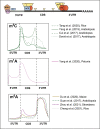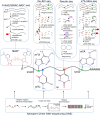The covalent nucleotide modifications within plant mRNAs: What we know, how we find them, and what should be done in the future
- PMID: 36794718
- PMCID: PMC10226571
- DOI: 10.1093/plcell/koad044
The covalent nucleotide modifications within plant mRNAs: What we know, how we find them, and what should be done in the future
Abstract
Although covalent nucleotide modifications were first identified on the bases of transfer RNAs (tRNAs) and ribosomal RNAs (rRNAs), a number of these epitranscriptome marks have also been found to occur on the bases of messenger RNAs (mRNAs). These covalent mRNA features have been demonstrated to have various and significant effects on the processing (e.g. splicing, polyadenylation, etc.) and functionality (e.g. translation, transport, etc.) of these protein-encoding molecules. Here, we focus our attention on the current understanding of the collection of covalent nucleotide modifications known to occur on mRNAs in plants, how they are detected and studied, and the most outstanding future questions of each of these important epitranscriptomic regulatory signals.
© American Society of Plant Biologists 2023. All rights reserved. For permissions, please e-mail: journals.permissions@oup.com.
Conflict of interest statement
Conflict of interest statement. The authors declare no conflicts of interest related to this work.
Figures


Similar articles
-
Comparative analyses suggest a link between mRNA splicing, stability, and RNA covalent modifications in flowering plants.BMC Plant Biol. 2024 Aug 12;24(1):768. doi: 10.1186/s12870-024-05486-7. BMC Plant Biol. 2024. PMID: 39134938 Free PMC article.
-
The impact of epitranscriptomic marks on post-transcriptional regulation in plants.Brief Funct Genomics. 2021 Mar 27;20(2):113-124. doi: 10.1093/bfgp/elaa021. Brief Funct Genomics. 2021. PMID: 33274735 Review.
-
Epitranscriptomic modifications in plant RNAs.RNA Biol. 2025 Dec;22(1):1-14. doi: 10.1080/15476286.2025.2515663. Epub 2025 Jun 8. RNA Biol. 2025. PMID: 40464679 Free PMC article. Review.
-
Polyuridylation in Eukaryotes: A 3'-End Modification Regulating RNA Life.Biomed Res Int. 2015;2015:968127. doi: 10.1155/2015/968127. Epub 2015 May 11. Biomed Res Int. 2015. PMID: 26078976 Free PMC article. Review.
-
Effects of mRNA Modifications on Translation: An Overview.Methods Mol Biol. 2021;2298:327-356. doi: 10.1007/978-1-0716-1374-0_20. Methods Mol Biol. 2021. PMID: 34085254 Review.
Cited by
-
RNA modifications in plant adaptation to abiotic stresses.Plant Commun. 2025 Feb 10;6(2):101229. doi: 10.1016/j.xplc.2024.101229. Epub 2024 Dec 21. Plant Commun. 2025. PMID: 39709520 Free PMC article. Review.
-
Reading m6A marks in mRNA: A potent mechanism of gene regulation in plants.J Integr Plant Biol. 2024 Dec;66(12):2586-2599. doi: 10.1111/jipb.13781. Epub 2024 Oct 4. J Integr Plant Biol. 2024. PMID: 39364713 Free PMC article. Review.
-
Transcriptome-Wide N6-Methyladenosine (m6A) Methylation Analyses in a Compatible Wheat-Puccinia striiformis f. sp. tritici Interaction.Plants (Basel). 2024 Mar 29;13(7):982. doi: 10.3390/plants13070982. Plants (Basel). 2024. PMID: 38611510 Free PMC article.
-
Focus on RNA biology.Plant Cell. 2023 May 29;35(6):1617-1618. doi: 10.1093/plcell/koad082. Plant Cell. 2023. PMID: 36943779 Free PMC article. No abstract available.
-
Comparative analyses suggest a link between mRNA splicing, stability, and RNA covalent modifications in flowering plants.BMC Plant Biol. 2024 Aug 12;24(1):768. doi: 10.1186/s12870-024-05486-7. BMC Plant Biol. 2024. PMID: 39134938 Free PMC article.
References
Publication types
MeSH terms
Substances
LinkOut - more resources
Full Text Sources

